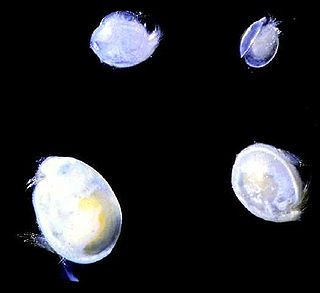 W
WCrayfish are freshwater crustaceans resembling small lobsters. In some locations, they are also known as crawfish, craydids, crawdaddies, crawdads, freshwater lobsters, mountain lobsters, rock lobsters, mudbugs, or yabbies. Taxonomically, they are members of the superfamilies Astacoidea and Parastacoidea. They breathe through feather-like gills. Some species are found in brooks and streams, where fresh water is running, while others thrive in swamps, ditches, and paddy fields. Most crayfish cannot tolerate polluted water, although some species, such as Procambarus clarkii, are hardier. Crayfish feed on animals and plants, either living or decomposing, and detritus.
 W
WThe Cephalocarida are a class in the subphylum Crustacea comprising only 12 benthic species. They were discovered in 1955 by Howard L. Sanders, and are commonly referred to as horseshoe shrimps. They have been grouped together with the Remipedia in the Xenocarida. Although a second family, Lightiellidae, is sometimes used, all cephalocaridans are generally considered to belong in just one family: Hutchinsoniellidae. Though no fossil record of cephalocaridans has been found, most specialists believe them to be primitive among crustaceans.
 W
WEntomostraca is a historical subclass of crustaceans, no longer in technical use. It was originally considered one of the two major lineages of crustaceans, combining all other classes—Branchiopoda, Cephalocarida, Ostracoda, Copepoda and Maxillopoda. The Ostracoda have the body enclosed in a bivalve shell-covering, and are normally unsegmented. The Branchiopoda have a very variable number of body-segments, with or without a shield, simple or bivalved, and some of the post-oral appendages normally branchial. The Copepoda normally have a segmented body, not enclosed in a bi-valved shell-covering, fewer than twelve segments, the limbs not branchial.
 W
WEpialtinae is a subfamily of crabs, containing the following genera:
 W
WMaxillopoda is a diverse class of crustaceans including barnacles, copepods and a number of related animals. It does not appear to be a monophyletic group, and no single character unites all the members.
 W
WOligostraca is a superclass within the Pancrustacea, containing the class Ostracoda and some of the polyphyletic class Maxillopoda.
 W
WOstracods, or ostracodes, are a class of the Crustacea, sometimes known as seed shrimp. Some 70,000 species have been identified, grouped into several orders. They are small crustaceans, typically around 1 mm (0.039 in) in size, but varying from 0.2 to 30 mm in the case of Gigantocypris. Their bodies are flattened from side to side and protected by a bivalve-like, chitinous or calcareous valve or "shell". The hinge of the two valves is in the upper (dorsal) region of the body. Ostracods are grouped together based on gross morphology. While early work indicated the group may not be monophyletic; and early molecular phylogeny was ambiguous on this front, recent combined analyses of molecular and morphological data found support for monophyly in analyses with broadest taxon sampling.